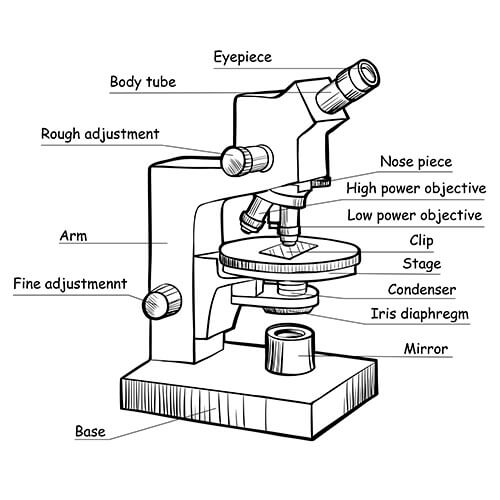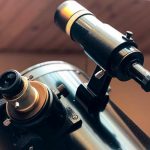What Is The Function Of The Condenser On A Microscope?
The condenser is an integral part of a microscope, but what is the function of the condenser on a microscope? A compound microscope condenser is an optical lens that helps focus light through what you’re viewing and onto the objective lens.
If you’re having problems viewing your sample, perhaps it’s too dark to see clearly, then you will need to adjust the microscope condenser.
You will find the condenser under the stage and over the top of the light source. The condenser’s function is to take the light source and narrow the beam to a cone of light to illuminate the specimen to be seen clearly—the condenser and diaphragm of the microscope work in conjunction with each other.
Depending on the objective lens, the aperture and the angle at which the light cone strikes the specimen will need adjusting.
A condenser usually consists of one or possibly more lenses and a variable-aperture diaphragm. Light passes through the diaphragm, onto the specimen focused by the lens or lenses. After light moves through the sample, it deviates into the cone of light we spoke about earlier and onto the objective lens.

Adjusting Light Intensity For A Microscope Condenser
A microscope condenser can only work to its optimal capacity when the light intensity setting is correct. Generally, lower magnification levels require less light. Which type of light you use on your microscope can also make a difference to a condenser’s function. For example, LED lights will be much brighter than a fluorescent light source. Adjusting the light intensity is easily accomplished by changing it on your microscope.
Optical Elements Of A Microscope
- Objective Lenses: these are the main lenses on the microscope. Ranging from 4x to 100x magnification and generally include three to five lenses. The objective lenses can be rear or forward-facing.
- Stage: is where you place the specimen or sample you wish to view. If you are working at higher magnifications and require tiny movements of the example or slide, you need to use a mechanical stage.
- Aperture: is the gap through which the light travels to reach the stage.
- Illuminator: can be found in the base of the microscope and is the light source. Light microscopes typically use halogen bulbs, control of which is in the bottom of the microscope.
- Condenser Iris Diaphragm: controls how much light shines onto the specimen. You can find the condenser’s iris diaphragm over the top of the condenser and underneath the stage. Top-quality microscopes typically use an Abbe condenser alongside an iris diaphragm. The microscope’s condenser and diaphragm combine to control the light’s amount and focus striking the sample.
- Condenser Focus Knob: focusing the light on the specimen is achieved by the focus knob, which moves the condenser up or down.
- Stage Clips: If the viewer is manually moving the slide to view different sample areas, stage clips are necessary.
- Eyepiece or Ocular: they are at the top of the microscope, and you look through them to view your sample. 10x magnification is typically the standard eyepiece; other eyepieces can increase magnification from 5x to 30x.
- Eyepiece Tube: this what holds the objective lens in position. If you’re using a binocular microscope (an optical microscope with two eyepieces, which can reduce eye strain), they generally include a diopter adjustment ring. This piece of equipment will offset any inconsistencies in your eyesight. It’s challenging to use a microscope wearing glasses, for instance. Single eye (monocular) microscopes will not incorporate a diopter. No two people have the same distance between their eyes, so a binocular microscope offers Interpupillary adjustment.
- Nosepiece: is where the objective lenses are situated. The objective lenses are on a rotating turret; this makes choosing the objective you require much easier. Typical objectives are 4x, 10x, 40x and 100x. Objectives with different power magnifications are also available.
- Coarse and Fine Focus knobs: Use the coarse focus knob to bring the sample almost into focus. Then fine-tune and sharpen the focus quality of the image with the Fine focus knob.

What Is The Abbe condenser?
Ernst Abbe was the inventor and creator of the Abbe condenser in 1870. This particular condenser uses an iris diaphragm and can be found below the stage of a microscope.
This Abbe uses the iris diaphragm to control and concentrate the diameter of the beam of light passing through a sample before it reaches the objective lens. Without such a system, it would be challenging to view the specimens accurately.
The Abbe is found in many modern microscopes even though it’s not suitable for magnification higher than 400x.
Aplanatic And Achromatic Condensers
The aplanatic condenser will correct for spherical aberration in the focused light path. A spherical aberration happens when light rays pass through a spherical surface and do not focus at the same point.
The achromatic compound condenser corrects chromatic aberrations as well as achromatic. An achromatic aberration is when a lens is incapable of bringing color wavelengths to the identical focal plane.
Microscope Condenser Installation
To install a microscope condenser, turn the coarse focus knob to move the stage up to its highest position; this way, it’s out of the way.
Generally, microscopes will have a knob to enable the raising and lowering of the condenser holder. To position the condenser inside the holder and under the stage, the holder will require lowering first. Once the condenser is inside the holder, tightening the screw on the holder’s side will hold it firmly in place. The condenser now needs to be in a position just below the microscope slide, do this by raising the condenser.
The condenser will also require centering. There are two screws on the holder for this purpose. Look through the microscope, making sure the iris is partly open and center the light in your viewer.
Conclusion
In this article, we’ve talked about the function of the condenser on a microscope and learned the condenser is one or more lenses that directly control the light that illuminates a specimen.
Without a condenser, the microscope would not focus the light emanating from the source correctly. There are different types of condensers to help correct light aberrations.
The condenser on a microscope is a vital piece of equipment without which a microscope wouldn’t function correctly.
















